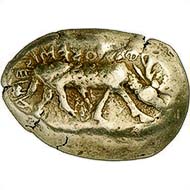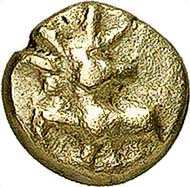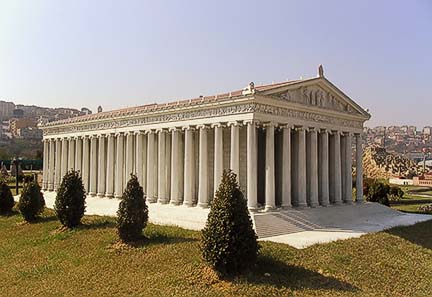The fourth known specimen of the Phanes staters on the market
On March 8th, 2010, Gorny & Mosch will present a specimen of the mysterious key series of the early coin production. The Phanes stater from a private collection in Israel is estimated at 150.000 Euros. It is the fourth specimen of the emission known to exist. One piece is owned by the British Museum, another was bought by the German Central Bank. A third example was sold at Tkalec in Zurich for 480.000 Swiss Francs to a private collector in February 2000. Apart from the four staters, five trites (third staters) are known. They all show the stag on the obverse. On the staters one can read the proud legend “Phanos emi Seima“ = I am the badge of Phanes.
Who produced the Phanes staters – and why?
At first, everything seems quite clear. Phanes, of course. But who was this Phanes? The sources do not tell us of a Phanes, or someone with a similar name, amongst the great kings of the early days. Does that mean that a civilian has put his name on these early coins?
With this question we are right in the middle of the academic debate. Why were the first coins produced in the first place?
Surely not – as Aristotle still thought – to facilitate the trade, since for centuries it had worked perfectly fine without any coins. And what trader would have been stupid enough to travel with an empty ship with just a handful of staters to buy goods only when he arrived in a foreign country? No substantial retail trade existed in the 7th century yet – hence, it did not seem to be the cause but rather the consequence of the introduction of the medium coin.
R. M. Cook seems to follow Heraclitus („War is father of all, king of all.”) when he hypothesizes that the first coins were produced in order to pay mercenary soldiers. That seems like a nice idea – only it requires a working retail trade. After all, the mercenary soldiers looked after themselves. How were they supposed to trade the big and valuable staters, trites and hectes at a farm for a chicken, a hunk of bread or a cup of wine? Even the 1/96th staters were still too valuable to pay the lunch with it.
The mentioned assumption had been modified suggesting that the staters were made as farewell gifts for mercenary soldiers and merited helpers but what were the smaller fractional parts produced for, then?
Colin Kraay proposed an interpretation of the coins as a state’s attempt to introduce its own currency system: the officials paid for works with the city’s money to get taxes, harbour dues and fines in return in their city’s currency. This would imply that the workers were labouring solely for the payments to the state – even the citizens of a modern state who are quite used to the exploitation by the government, would protest against that. An ancient Greek would be very surprised by such an idea!
The characteristics of electrum
All of the above mentioned ideas could be summarized under the simple heading: the coin was invented to meet a certain requirement. But what if the coin, in contrast, were a by-product of a different problem? After all, it was exactly the material electrum that faced anyone with the task of determining the correct content of gold and silver of the individual piece quickly and without a melting pot.
We do in fact know from metallurgic studies that the first coins were anything but mere metal blobs fished from the river Paktolos. The Lydian kings had the metal alloy for the coinage carefully and artificially put together to ensure that the content of gold and silver was always the same. It is possible, therefore, that the first coins were nothing else than small metal bars whose badges guaranteed the ever same alloy.
And what about Phanes?
Our Phanes might well have been a rich tradesman signing his little bars made of electrum with his own badge to confirm the stable metal alloy. But why – and this question arises instantly – didn’t he separate the gold from the silver in the first place to make such a signing redundant?
Perhaps there really was another reason for producing coins?
Wolfgang Kastner, in the Schweizerische Numismatische Rundschau 65 (1986), has pointed to the right direction when he realized that, due to linguistic reasons, “Phannos“ – or “Phaneos“ as the name appears on the coins – cannot be the genitive of a male name. He assumes that the legend refers to a goddess called “Phano” or a place name, “Phane / Phanai”.
The biggest find of electrum coins from an archaeological excavation comes from a sanctuary, that of Artemis in Ephesus. We know that gold and silver were given by the rich as donation and that is was customary to explicitly sign one’s votive to enhance one’s own reputation – and that the Lydians, who Herodotus credited as the “inventors” of the coin, were particularly loyal patrons of the different Greek sanctuaries. Does it not seem reasonable to assume, then, that the first coins really were votives to the gods whose usefulness the priests and servants soon began to realize?
Some things remain in the dark
It is a hypothesis that – like any other – has no chance of being verified or proven false. The man who “invented” the very first coin is dead and sadly has left us with no record of his motivations. Perhaps he did not even realized that he, when he put his image on a little blob of metal, was about to change the world forever.
EPHESUS(?). Phanes. Stater, 625-600 B. C. Grazing stag r., above retrograde the legend Phanos emi Seima. Rev. Three rectangular incuse designs with decussate lines. Weidauer 39 (same die). From Gorny & Mosch auction 185 (2010), no. 146.
EPHESUS(?). Phanes(?). 1/12th stater, 625-600 B. C. Stag protome l. Rev. Quadrisected incuse design. Weidauer 38. From Gorny & Mosch auction 186 (2010), no. 1375.
Traditionally, these small coins with the stag protome without legend are attributed to Phanes. That would call the localization of the coinage in Ephesus into question since Karwiese has identified the so-called “Lion Paws” as the earliest electrum coinage of Ephesus. He points to the fact that the stag protome regularly appears in Colophon.
This line of argument, though, postulates that a city only had one coinage at a time. But is it likely that a municipal government had decreed a monopoly on coins that fast? Or were modern ideas projected on antiquity here?
LYDIA. Indeterminate king. Trite, 600-550 B. C. Lion head with open jaw and multi-radial wart r. Rev. Two rectangular incuse punches. Weidauer pp. 86. From Gorny & Mosch auction 185 (2010), no. 160.
Temple of Artemis. Model in the Miniatürk amusement park. Photo: Wikipedia.
From the foundation of the Temple of Artemis in Ephesus comes our biggest find of excavated early electrum coins. Unfortunately, the context does not give any reliable chronological clue due to an unclear building situation.










